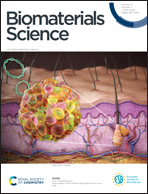One-pot reaction for the preparation of diatom hemostatic particles with effective hemostasis and economic benefits
Abstract
Effective hemostatic materials have been in demand for rapid pre-hospital hemostasis in emergency situations, which can significantly reduce accidental deaths. The development of emergency hemostatic materials with rapid hemostasis, biosafety, and economical preparation is a great challenge. In this study, Ca(OH)2-complexed diatom powder hemostatic particles (Ca(OH)2-Php) were prepared based on a one-pot reaction by directly mixing various raw materials and by rotary granulation. High-temperature calcination was able to carbonate and consume the organic matter in the hemostatic particles. The crosslinked hydrogen bonds in those particles were converted to silica-oxygen bonds, the particles became more stable, and the porous structure of diatom biosilica (DBs) was exposed. Ca(OH)2-Php has high porosity, can quickly adsorb the water in blood (water absorption: 75.85 ± 6.93%), and exhibits rapid hemostasis capacity (clotting time was shortened by 43% compared with that of the control group), good biocompatibility (hemolysis rate <7%, no cytotoxicity), and simplicity of handling (conveniently debride, no residues, no tissue inflammation). This study provides a new idea for the preparation of emergency hemostatic materials, and Ca(OH)2-Php prepared by one-pot reaction has various high-quality characteristics including rapid hemostasis, wide applicability, economical preparation, and potential for large-scale production.



 Please wait while we load your content...
Please wait while we load your content...